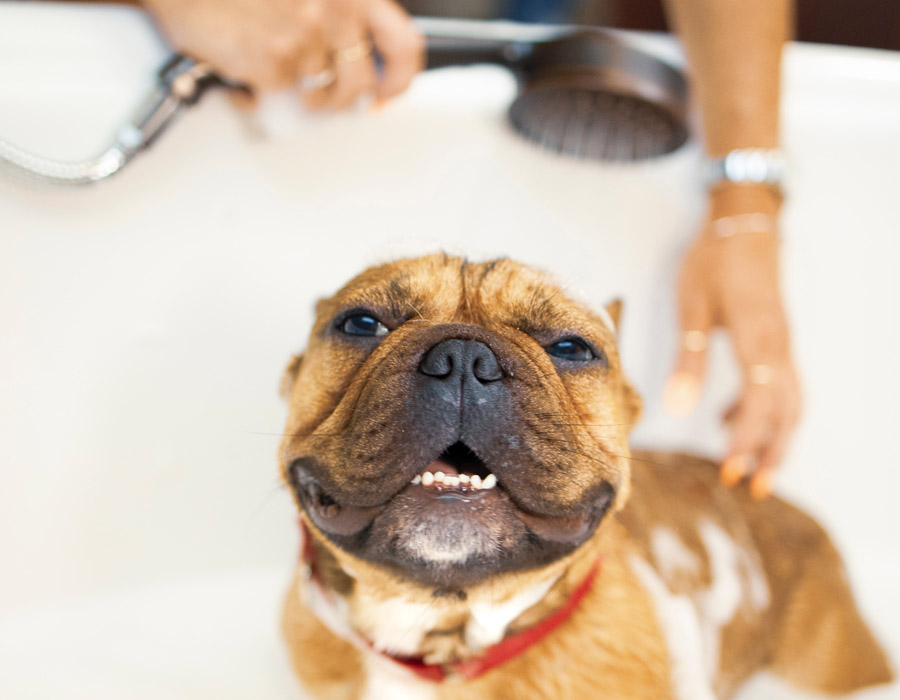Just because you’re a dog walker or a pet sitter—and not a dog groomer— it doesn’t mean you get away with not bathing your clients’ dogs. Sometimes, things happen, dogs get super dirty or ultra smelly and a bath is the only solution.
In fact, it pays for all pet professionals to reacquaint themselves with the essentials of dog grooming. This way you’ll be prepared for a safe, stress-free doggy bath time—if the need should arise! Plus, you can offer up a few useful dog-grooming tips, should your clients ever ask.
Recognising the signs of stress
Let’s face it, some dogs simply don’t like being bathed or groomed. It might be the water they dislike, the smell of the shampoo, or just the fact they hate being handled.
It’s important for pet professionals and owners alike to understand the signs of fear and stress so that actions can be taken to ease these feelings.
Typically, a dog will display one or more of the following signs when feeling stressed or anxious.
- Panting
- Shaking
- Teeth chattering
- Whining, barking or howling
- Cowering or hiding
Taking the stress out of dog grooming
Assuming you have the essentials (dog shampoo, scissors, brushes etc) and an appropriate place to bath a dog, reducing the stress that can be associated with dog grooming is all about positive reinforcement.
Certainly, some of your clients’ dogs may not be used to being bathed, so it’s important to take measures to ease their anxiety. What’s more, helping canine clients to feel secure and comfortable will help foster a long-lasting, trusting relationship.
To help guide your behaviour, keep the acronym LIMA in mind. This stands for ‘least intrusive, minimally aversive’. It can be used by anyone who works in the animal industry to help evoke calm and trust.
Take things slow to begin, as this will help you to work out whether your canine client is familiar with baths or has a dislike for them. Use treats as positive reinforcement and encouragement.
In some cases, you may be able to ditch the bath altogether. For example, if you’ve returned from taking your fur client on a walk and he’s a bit smelly or dirty, you might be able to clean and deodorize with these handy no-bath methods.
Use wipes to get rid of the bulk of the dirt and then give the dog a good old brush. This will help remove most of the dirt and may reduce the smell.
Dry shampoo for pets is a great product to have on hand. No foaming, no rinsing, no water at all! Dry shampoo will have your fur client looking and smelling fresher in minutes, minus the stress of bathing.
Pet grooming tips for your clients
Of course, as pet professionals, you are in an ideal position to advise pet owners on the importance of introducing their pets to grooming at a young age. The earlier pets become familiar with water, the sound of the dryer and the unfamiliar space of the pet salon (or laundry sink!), the better.
It may sound obvious but advise your clients to keep some treats within arms reach. Treats are a great way to distract a pet that’s feeling fearful.
Advise pet owners to start slowly when it comes to grooming. The best method is to start small. Suggest they begin by simply washing their pet’s paws. The next time around they can move to the legs and maybe the body. Eventually, they’ll be able to give their pet a full-on bath. Of course, this all takes a good dose of patience!
If it all becomes far too difficult for your client or stressful for their pet, suggest they employ the services of a local pet groomer. After all, pet groomers are trained to deal with different animal temperaments and overcome common fears.
Have you encountered a fur client that’s afraid of baths or grooming?










I’d be interested to know your views on a dog groomer I live above.
From what I can tell no effort is made to comfort the client’s dogs when they are in the bath or having the hair dryer. Barking/ screaming and crying occurs for often around 20 minutes or longer depending. Quite often you’ll hear them growl and get aggressive while struggling to get away from what is being done to them. There is always lots of sounds of a struggle. She makes no effort to comfort and work through the issues- I’d expect her to stop and pet them etc but you will instead hear her shouting at said dogs and often swearing at them. Not only is this a massive noise issue for us as we are hearing all of this in our flats but I’m very concerned about their welfare.
Doesnt sounds like a groomer that I would like to groom my dogs.
If you are concerned you can report to your local council animal welfare department